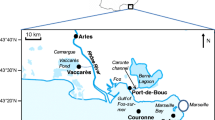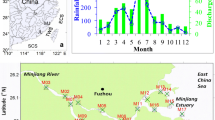Abstract
Dissolved fluorescent organic matter was measured using fluorescence excitation-emission matrix spectroscopy at three temporal points during a Synechococcus bloom after diatom bloom dispersion in spring, 2007. Carbohydrate and dissolved organic carbon were also analyzed. The relationship between organic matter and red tide succession was examined. The results show that after the diatom bloom, tyrosine-like fluorescence B intensity was very high within the water column and exhibited a negative correlation with chlorophyll a over the period of the Synechococcus bloom. Other organic matter did not exhibit this relationship with chlorophyll a. This implied that diatom bloom dispersion resulted in the release of large quantities of tyrosine-like compounds into the water. These may play a role as a nutrient source or growth-stimulating substance for the subsequent Synechococcus bloom.
Similar content being viewed by others
References
André M. 1997. Consequences of a Synechococcus bloom upon the optical properties of oceanic (case 1) waters. Limnol. Oceanogr., 42(8): 1 746–1 754.
Coble P G, Green S, Blough N V, Gagosian R B. 1990. Characterization of dissolved organic matter in the Black Sea by fluorescence spectroscopy. Nature, 348(29): 432–435.
Coble P G. 1996. Characterization of marine and terrestrial DOM in seawater using excitation-emission matrix spectroscopy. Mar. Chem., 51: 325–346.
Coble P G, Del Castillo C E, Avril B. 1998. Distribution and optical properties of CDOM in the Arabian Sea during the 1995 Southwest Monsoon. Deep Sea Res., 45: 2 195–2 223.
Edward J P, Susan B, Tammy C L. 1999. Blooms of the picoplanktonic cyanobacterium Synechococcus in Florida Bay, a subtropical inner-shelf lagoon. Limnol. Oceanogr., 44(4): 1 166–1 175.
Fogg G E, Westlake D E. 1955. The importance of extracellular products of algae in freshwater. Mitteilungen der Internationale Vereinigung fur theoretische angewandte Limnologie, 12: 219–232.
Glover H E, Prézelin B B, Campbell L et al. 1988. A nitratedependent Synechococcus bloom in surface Sargasso Sea water. Nature, 331: 161–163.
Ji N Y, Zhao W H, Cui X, Wang J T, Miao H, Wang L. 2004. Fluorescence characterization of dissolved organic matter in Jiaozhou Bay. Periodical of Ocean University of China, 34: 197–203. (in Chinese with English abstract)
Ji N Y, Zhao W H, Wang J T, Cui X, Miao H. 2006. Fluorescence characteristics of dissolved organic matter during algal bloom in Jiaozhou Bay. Chinese Journal of Environmental Science, 27(2): 257–262. (in Chinese with English abstract)
Li W K W, Subba R D V, Harrison J C. 1983. Autotrophic picoplankton in the tropical ocean. Science, 219: 292–295.
Myklestad S M, Skanoy E, Hestmann S. 1997. A sensitive and rapid method for analysis of dissolved mono- and polysaccharides in seawater. Mar. Chem., 56(3–4): 279–286.
Powell L M, Bowman J P, Skerratt J H et al. 2005. Ecology of a novel Synechococcus clade occurring in dense populations in saline Antarctic lakes. MEPS, 291: 65–80.
Thierry M, Tron F T, Van Wambeke F et al. 2002. Does competition for nanomolar phosphate supply explain the predominance of the cyanobacterium Synechococcus. Limnol. Oceanogr., 47(5): 1 562–1 567.
Wawrik B, Callaghan A V, Bronk D A. 2009. Use of inorganic and organic nitrogen by Synechococcus spp. and diatoms on the West Florida Shelf as measured using stable isotope probing. Applied and Environmental Microbiology, 75(21): 6 662–6 670.
Zhao W H, Wang J T, Chen M M. 2009. Three-dimensional fluorescence characteristics of dissolved organc matter produced by Prorocentrum donghaiense Lu. Chin. J. Oceanol. Limnol., 27(3): 564–569.
Zhao W H, Wang J T, Cui X, Ji N Y. 2006. Research on fluorescence excitation and emission matrix spectra of dissolved organic matter in phytoplankton growth process. Chinese High Technology Letters, 16(4): 425–430. (in Chinese with English abstract)
Zhang H F, Wang J H, Liu C C. 2008. Synechococcus spp. bloom and its ecological significance. Marine Environment Sciences, 27: 105–108. (in Chinese with English abstract)
Zhou M J, Zhu M Y. 2006. Progress of the project “Ecology and oceanography of harmful algal blooms in China”. Advances in Earth Science, 21(7): 673–679. (in Chinese with English abstract)
Zhuo P J, Zhao W H. 2009. Fluorescence charaterization of dissolved organci matter in the East China Sea after diatom redtide dispersion. Spectroscopy and Spectral Analysis, 29(5): 1 349–1 353. (in Chinese with English abstract)
Author information
Authors and Affiliations
Corresponding author
Additional information
Supported by the National High Technology Research and Development Program of China (863 Program) (No. 2006AA09Z180), the Knowledge Innovation Program of Chinese Academy of Sciences (No. KZCX2-SW-208-1), and the National Basic Research Program of China (973 Program) (No. 2010CB428701)
Rights and permissions
About this article
Cite this article
Zhao, W., Zhuo, P. Dissolved organic matter and its role in red tide succession in the East China Sea in spring. Chin. J. Ocean. Limnol. 29, 795–799 (2011). https://doi.org/10.1007/s00343-011-0508-6
Received:
Accepted:
Published:
Issue Date:
DOI: https://doi.org/10.1007/s00343-011-0508-6




